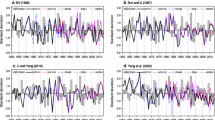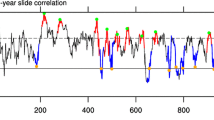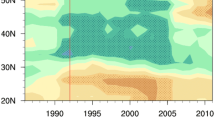Abstract
Orbital forcing influences climate phenomena by changing incoming solar radiation in season and latitude. Here, changes in the El Niño-Southern Oscillation (ENSO)’s impact on the East Asian winter monsoon (EAWM) due to orbital forcing, especially for three selected time periods in each of two interglacial periods, the Eemian (126, 122, 115 ka) and Holocene (9, 6, 0 ka), are investigated. There was a high negative correlation between ENSO and EAWM when the obliquity was low, the processional angle was large, and especially when accompanied by large eccentricity, which corresponds to a weaker monsoon period. The correlation was also high when ENSO variability was high, which interestingly corresponded to lower obliquity and higher-degree precession periods. Therefore, as both lower obliquity and higher-degree precession, such as during 115 ka and 0 ka, cause the EAWM to be weakened through higher winter insolation over Northern hemisphere, and the ENSO to be enhanced through an intensified zonal contrast of the equatorial sea surface temperature, the relationship between the ENSO and EAWM becomes tighter. The opposite case (i.e., during 126 and 9 ka) is also true dynamically. Furthermore, the sensitivity of boreal winter precipitation against sea surface temperature (SST) anomaly over the tropical Pacific, which depends on mean SST, was positively correlated to the strength of the ENSO-EAWM correlation, implying that the warmer mean ocean surface causes the strong response of atmosphere to change in the SST anomaly, thereby enhancing the impact of ENSO on EAWM. Warmer wintertime tropical SST is attributed to higher insolation over the tropics, especially during 115 and 0 ka, while cooler SSTs occurred during 126 and 9 ka.







Similar content being viewed by others
References
An SI, Bong H (2016) Inter-decadal change in El Niño-Southern Oscillation examined with Bjerknes stability index analysis. Clim Dyn 49: 967–979. doi:10.1007/s00382-015-2883-8
An SI, Choi J (2014) Mid-Holocene tropical Pacific climate state, annual cycle, and ENSO in PMIP2 and PMIP3. Clim Dyn 43:957–970
An SI, Choi J (2015) Why the Twenty-first century tropical Pacific trend pattern cannot significantly influence ENSO amplitude. Clim Dyn 44:133–146
An SI, Timmermann A, Bejarano L, Jin FF, Justino F, Liu Z, Tudhope A (2004) Modeling evidence for enhanced El Niño–Southern Oscillation amplitude during the last glacial maximum. Paleoceanography 19:PA4009. doi:10.1029/2004PA001020
Caley T, Roche DM, Renssen H (2014) Orbital Asian summer monsoon dynamics revealed using an isotope-enabled global climate model. Nat Commun 5:5371
Clement AC, Seager R, Cane MA (1999) Orbital controls on the El Niño/Southern Oscillation and the tropical climate. Paleoceanography 14:441–456
Guilyardi E (2006) El Niño-mean state-seasonal cycle interactions in a multi-model ensemble. Clim Dyn 26: 329–348
Hori ME, Abe M, Yasunari T, Kitoh A (2008) Influence of orbital forcing on the seasonality and regionality of the Asian summer monsoon precipitation. Clim Past Discuss 4: 719–740
Jin F-F, Kim ST, Bejarano L (2006) A coupled-stability index for ENSO. Geophys Res Lett 33:L23708. doi:10.1029/2006GL027221
Kim JW, Yeh SW, Chang EC (2014) Combined effect of El Niño-Southern Oscillation and Pacific decadal oscillation on the east Asian winter monsoon. Clim Dyn 42: 957–971
Koutavas A, Joanides S (2012) El Niño-Southern Oscillation extrema in the Holocene and last glacial maximum. Paleoceanography 27:PA4208. doi:10.1029/2012PA002378
Kutzbach JE (1981) Monsoon climate of the early Holocene: climate experiment with Earth’s orbital parameter for 9000 years ago. Science 214: 59–61
Kutzbach J, Liu X, Liu Z, Chen G (2008) Simulation of the evolutionary response of global summer monsoons to orbital forcing over the past 280,000 years. Clim Dyn 30:567–579
Liu Z, Lu Z, Wen X, Timmermann A, Cobb KM (2014) Evolution and forcing mechanisms of El Niño over the last 21,000 years. Nature 515(7528):550–553
Luan Y, Braconnot P, Yu Y, Zheng W, Marti O (2012) Early and mid-Holocene climate in the tropical Pacific: seasonal cycle and interannual variability induced by insolation changes. Clim Past 8:1093–1108
Luo JJ, Masson S, Roeckner E, Madec G, Yamagata T (2005) Reducing climatology bias in an ocean–atmosphere CGCM with improved coupling physics. J Clim 18:2344–2360
Madec G (2008) NEMO ocean engine. Note du Pole de modélisation 27, Institut Pierre-Simon Laplace, pp 193
McGregor HV, Gagan MK (2004) Western Pacific coral δ18O records of anomalous Holocene variability in the El Niño-Southern Oscillation. Geophys Res Lett 31:L11204
Morley JJ, Heusser LE (1997) Role of orbital forcing in east Asian monsoon climates during the last 350 kyr: evidence from terrestrial and marine climate proxies from core RC14-99. Paleoceanography 12:483–493
Park W, Latif M (2008) Multidecadal and multicentennial variability of the meridional overturning circulation. Geophys Res Lett 35:L22703. doi:10.1029/2008GL035779
Park W, Latif M (2010) Pacific and Atlantic multidecadal variability in the Kiel climate model. Geophys Res Lett 37:L24702. doi:10.1029/2010GL045560
Park W, Latif M (2012) Atlantic meridional overturning circulation response to idealized external forcing. Clim Dyn 39: 1709–1726
Park W, Keenlyside N, Latif M, Ströh A, Redler R, Roeckner E, Madec G (2009) Tropical Pacific climate and its response to global warming in the Kiel Climate Model. J Clim 22:71–92
Raymo ME (1994) The initiation of Northern Hemisphere glaciation. Annu Rev Earth Planet Sci 22: 353–383
Sakai K, Kawamura R (2009) Remote response of the East Asian winter monsoon to tropical forcing related to El Niño-Southern Oscillation. J Geophys Res 114:D06105. doi:10.1029/2008JD010824
Salau OR, Schneider B, Park W, Khon V, Latif M (2012) Modeling the ENSO impact of orbitally induced mean state climate changes. J Geophy Res 117:C05043. doi:10.1029/2011JC007742
Schneider B, Leduc G, Park W (2010) Disentangling seasonal signals in Holocene climate trends by satellite-model-proxy integration. Paleoceanography 25:PA4217. doi:10.1029/2009PA001893
Shi Z, Liu X, Cheng X (2012) Anti-phased response of northern and southern East Asian summer precipitation to ENSO modulation of orbital forcing. Quatern Sci Rev 40:30–38
Tudhope AW, Chilcott CP, McCulloch MT, Cook ER, Chappell J, Ellam RM, Lea DW, Lough JM, Shimmield GB (2001) Variability in the El Niño-Southern Oscillation through a glacial-interglacial cycle. Nature 291:1511–1517
Wang H, He S (2012) Weakening relationship between East Asian winter monsoon and ENSO after mid-1970s. Chin Sci Bull 57:3535–3540. doi:10.1007/s11434-012-5285-x
Wang B, Zhang Q (2002) Pacific-East Asian teleconnection. Part II: how the Philippine Sea anomalous anticyclone is established during El Niño development. J Clim 15:3252–3265
Wang B, Wu R, Fu X (2000) Pacific-East Asian teleconnection: how does ENSO affect East Asian climate? J Clim 13:1517–1536
Wen X, Liu Z, Wang S, Cheng J, Zhu J (2016) Correlation and anti-correlation of the east Asian summer and winter monsoons during the last 21,000 years. Nat Commun 7:11999
Woodroffe CD, Beech MR, Gagan MK (2003) Mid-late Holocene El Niño variability in the equatorial Pacific from coral microatolls. Geophys Res Lett 30:1358–1361
Xie S-P (1994) On the genesis of the equatorial annual cycle. J Clim 7:2008–2013
Yancheva G, Nowaczyk NR, Mingram J, Dulski P, Schettler G, Negendank JFW, Liu J, Sigman DM, Peterson LC, Haug GH (2007) Influence of the intertropical convergence zone on the East Asian monsoon. Nature 445:74–77
Yang S, Lau KM, Kim KM (2002) Variations of the east Asian jet stream and Asian–Pacific–American winter climate anomalies. J Clim 15:306–325
Zheng X, Li A, Wan S, Jiang F, Kao SJ, Johnson C (2014) ITCZ and ENSO pacing on east Asian winter monsoon variation during the Holocene: sedimentological evidence form the Okinawa trough. J Geophys Res. doi:10.1002/2013JC009603
Acknowledgements
This work was supported by a National Research Foundation of Korea Grant funded by the Korean Government (MEST) NRF-2009-0093069. The model integrations were performed at the Computer Centre at Kiel University.
Author information
Authors and Affiliations
Corresponding author
Rights and permissions
About this article
Cite this article
An, SI., Kim, HJ., Park, W. et al. Impact of ENSO on East Asian winter monsoon during interglacial periods: effect of orbital forcing. Clim Dyn 49, 3209–3219 (2017). https://doi.org/10.1007/s00382-016-3506-8
Received:
Accepted:
Published:
Issue Date:
DOI: https://doi.org/10.1007/s00382-016-3506-8




